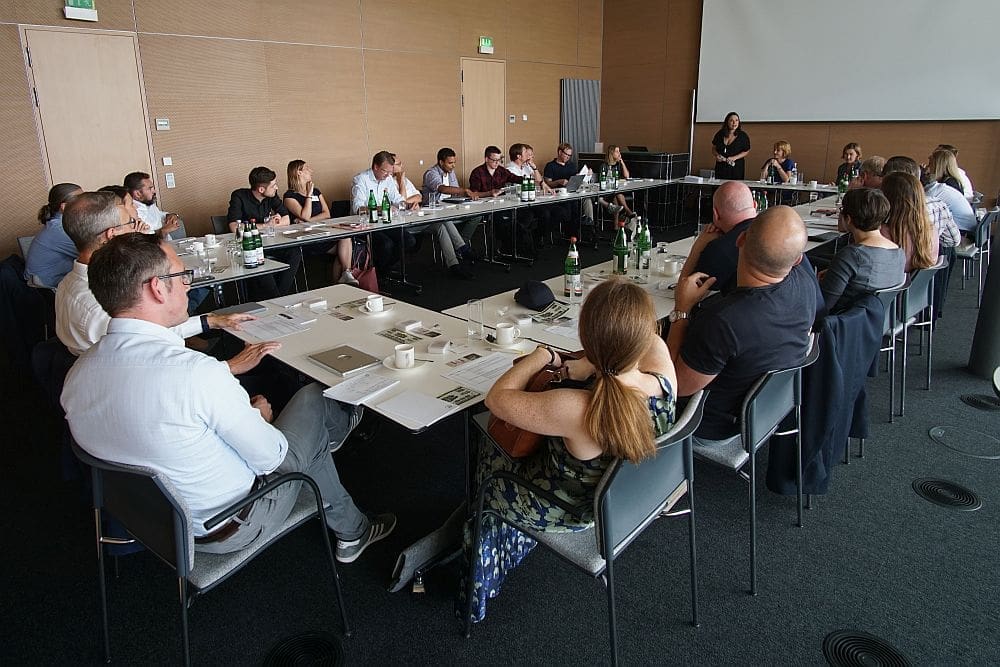Seven tips for the ideal pitch deck
Until August 25th you can apply for our Reeperbahn Startup Pitch. One of the conditions of participation is the submission of an English pitch deck with a maximum of 15 slides. In this context the eternal question arises: What does the ideal pitch deck look like? In the following article we’ll give you a few tips.
The jack of all trades pitch deck does not exist
One thing should be clear to every startup: With only one pitch deck nobody gets along. And this does not mean that you should have at least a German and an English version ready. Rather, it’s about covering different situations and target groups. For example, it makes a difference whether you want to convince investors of your company in a small circle or a larger audience at a public pitch. Another factor: Do the viewers have time to look at the slides in silence, or is the pitch deck rather the supplementary source of information for a personal presentation? In our tips, we will concentrate on the type of pitch deck that is most suitable for an event like the Reeperbahn Startup Pitch. However, we will also briefly discuss other variants from time to time and a lot of things are basically valid in any case.
Always keep in shape
Three different fonts, five different font sizes, the company logo at the top left, at the bottom right or not at all – these are, only slightly exaggerated, a few rules of thumb how not to do it. Make your slides as readable and clear as possible and stick to a clear layout. Use high quality and expressive images; where it fits, humor is welcome. With a carefully designed pitch deck you indicate that you can also work structured otherwise.
Getting to the point
Apropos readability: The people who are supposed to check your pitch decks have enough time to take a close look at them – theoretically. In practice, however, no one wants to fight their way through long texts to find out what you are actually doing and what you have in mind. That’s why the following applies to every pitch deck: formulate briefly, comprehensibly and to the point. For an application slides can contain some more information and somewhat more text. This is different with a public pitch. There it is best to have only one essential piece of information and as little text as possible on each slide. Jury and audience should listen to you and not laboriously try to read everything somewhere.

At the meeting of the advisory board, which determines the participants of the Reeperbahn Startup Pitch, pitch decks are an important decision aid.
Name problem, solve problem
Every good startup owes its origin to a problem for which there has been no satisfactory solution so far. You don’t have to save the world, but it has to be recognizable which advantage your idea brings. The pitch deck should therefore contain one or two slides that represent the problem. For a complex technical topic you should choose an example that is comprehensible for anyone. The jurors are usually startup experts, but not equally well versed in all technological areas. Once the problem has been identified and named, your solution follows on another one or two slides. If this is conclusive, you are already a decisive step ahead. A tip: Test your problem solving slides with friends who are not from your department. If they understand everything, you’ve obviously done something right.
Data, facts and forecasts – and always thinking of investors
Problem recognized, problem solved – now everything is good? Maybe for you, but can you also earn money with it? No pitch deck should be without proof that your idea and your product can also be used commercially. Make it clear that there is a customer potential for your startup that offers good sales and growth opportunities. You have to avoid some pitfalls. Too many and detailed figures tend to create confusion, pick out the most unambiguous and impressive data. Beware also of any forecasts à la „The entire world market is worth 100 billion euros. If we reach only 1% of that, we are already billionaires.“ That might be somehow correct, but worthless, if you can’t plausibly explain how you want to collect even this one percent. After all, a complete market analysis includes naming your competitors and what sets you apart from them. Remember that even the kindest investor would like to earn money with you, so convince him with sound data and facts.
The team wins
An old investor rule is to put your money on a great team with a moderate idea rather than on a lousy team with a good idea. Of course, a pitch deck doesn’t reveal how well you actually work together, but there may be a few hints. It should show that the team members have different skills and biographies that combine to form a promising whole. Small extra tip: A group photo may convey this impression of unity more strongly than a series of individual photos. In larger startups, for example, individual portraits of the founding trio and a picture of the entire team could work well.
The icing on the cake
If you consider all the points mentioned so far, your pitch deck should already have a lot of plus points. You can get a small bonus if you explain on a slide why you are predestined for this one competition. Let’s take our Reeperbahn Startup Pitch as an example. Do you have a special relation to Hamburg, to the Reeperbahn or to music (the pitch takes place at the Mojo Club after all)? Why should you win the main prize, the trip to the SXSW Festival in Austin, Texas? A conclusive, original or funny reason can increase the sympathy credit if everything else is right.
Do you now feel well prepared for a successful application? Then start right away and go to our website, where you can find out everything about the Reeperbahn Startup Pitch. We are looking forward to seeing you!








